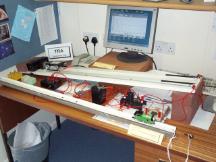Transport on Track (TRA)
Urban light railways and tram systems are being installed in many cities in the UK and elsewhere. Railway systems have, almost from their beginnings, made use of physics-related technology and this chapter examines various principles involved today. How are short-circuits used in signalling systems and what problems can be caused by saline ballast or leaves on the line?
What techniques can be used to sense the speed of a train and control it via an on-board computer? How could eddy-currents provide a non-contact braking system? These are just a few of the electrical and electronic elements of this chapter.

The past half century has seen improvements in the design of rolling stock and this is one of the elements that provides opportunities for students to look at momentum and energy conservation, and consider carriage and buffer designs that minimise the forces on passengers in collisions.
The photograph shows two activities that use sensors and a PC interface to gather and display data. In the foreground, a magnet mounted on a model train induces an emf in small coils of wire beneath the track, providing a signal that indicates the train’s speed. Behind, a track slopes down to a buffer containing a force sensor enabling students to relate a force-time trace to measurements of a model train’s momentum.
The main physics content areas are:
- DC circuits and switching
- Force, momentum, work and energy
- Magnetic fields: electromagnetic force
- Electromagnetic induction
- Capacitors: exponential discharge
